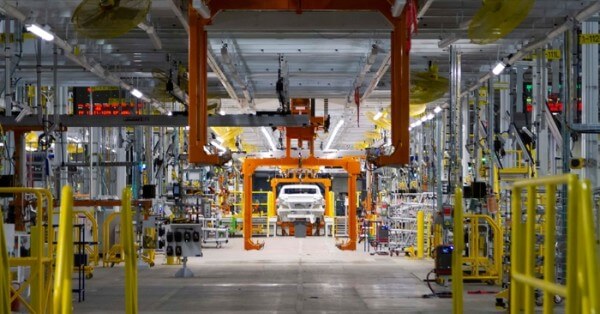AI to Reshape GM’s Factories, Robots, and Self-Driving Technology
General Motors (GM) is strengthening its collaboration with NVIDIA to bring AI-powered intelligence to every aspect of its business, from factory floors to vehicle design and in-car systems. Announced at the NVIDIA GTC conference by CEO Jensen Huang, the partnership aims to integrate AI into GM’s manufacturing, enterprise operations, and vehicle technology, enhancing efficiency, automation, and safety.
NVIDIA will provide GM with AI infrastructure, including GPUs, to support AI training, simulation, and real-time processing across different automotive applications. By leveraging NVIDIA’s expertise, GM plans to modernize factory operations, improve vehicle development through AI-driven simulation, and enhance driver-assistance systems in its next-generation vehicles.
AI-Driven Manufacturing: Digital Twins and Intelligent Robotics
A key component of this collaboration is GM’s adoption of digital twin technology powered by NVIDIA Omniverse with Cosmos. This technology allows GM to create virtual replicas of its factories, assembly lines, and robotics systems, enabling AI-driven simulation and optimization.
Benefits of AI in Manufacturing
- Factory Optimization: By simulating production processes in a digital environment, GM can test new strategies, optimize workflows, and minimize disruptions before implementing changes on the factory floor.
- AI-Powered Robotics: GM is training robotic systems using NVIDIA AI to handle tasks such as material transport, automated welding, and quality control, improving manufacturing efficiency and worker safety.
- Reduced Downtime: Predictive analytics and AI-driven monitoring can help identify potential issues before they disrupt production, leading to increased uptime and lower maintenance costs.
This AI-enhanced automation aligns with GM’s goal of building smarter, more adaptive factories that can quickly respond to new vehicle designs and production demands.
Enterprise AI: Smarter Vehicle Design and Faster Development
Beyond factory floors, AI is transforming how GM designs and tests its vehicles. NVIDIA’s AI-powered simulation tools are enabling faster prototyping, improved safety validation, and enhanced performance optimization.
How AI is Accelerating Vehicle Development
- Real-Time Simulations: AI allows engineers to simulate thousands of vehicle designs in a virtual environment, reducing reliance on physical prototypes and cutting development time.
- Crash Testing and Safety Improvements: AI-powered models can predict how vehicles will perform in crash scenarios, helping GM enhance structural integrity and occupant safety.
- Energy Efficiency and Performance: AI-driven design optimizations help improve aerodynamics, battery efficiency (for EVs), and overall vehicle performance.
With NVIDIA’s accelerated computing and AI-driven simulations, GM can create safer, more efficient, and technologically advanced vehicles while reducing costs and time-to-market.
Advanced Driver-Assistance and Autonomous Vehicles
GM’s next-generation vehicles will incorporate NVIDIA DRIVE AGX, a high-performance computing platform based on the Blackwell architecture, designed to support advanced driver-assistance systems (ADAS) and autonomous driving features.
NVIDIA-Powered AI for Smarter, Safer Vehicles
- Enhanced ADAS: NVIDIA DRIVE AGX will power Super Cruise, GM’s hands-free driver-assistance system, providing improved lane-keeping, real-time navigation, and better hazard detection.
- In-Cabin Safety Features: AI-driven driver monitoring and passenger safety systems will enhance the driving experience, ensuring greater security on the road.
- Scalable Autonomy: The platform’s ability to process up to 1,000 trillion operations per second will support GM’s long-term vision for fully autonomous personal vehicles.
GM recently shifted its focus from commercial robotaxis to personal autonomous vehicles, integrating AI-powered self-driving capabilities into consumer cars rather than relying solely on fleet-based autonomy. NVIDIA’s AI infrastructure will play a crucial role in making highly automated driving systems a reality.
A Long-Term AI Collaboration for the Future of Automotive Innovation
GM has been using NVIDIA GPUs for years to train AI models for simulation and validation, but this latest expansion significantly deepens the partnership. By leveraging AI, digital twins, robotics, and high-performance computing, GM is setting a new standard for automotive innovation, efficiency, and safety.
Jensen Huang, CEO of NVIDIA, emphasized the transformative potential of AI in the auto industry: “We’re working with GM to revolutionize manufacturing, enterprise design, and in-vehicle AI. AI is now a core part of the automotive world, and our collaboration will push the boundaries of what’s possible.”
By integrating NVIDIA-powered AI into factories, enterprise operations, and vehicles, GM is paving the way for the next era of automotive intelligence, efficiency, and autonomous driving.




























